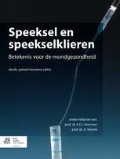Samenvatting
-
Speeksel wordt geproduceerd door verschillende typen klieren, die elk een secreet met een karakteristieke biochemische samenstelling uitscheiden.
-
De grote verschillen in samenstelling tussen verschillende klierspeeksels is een van de oorzaken van de variaties in kwantiteit en in kwaliteit van speeksel, zowel binnen een persoon als tussen personen.
-
Factoren die een rol spelen zijn onder andere dag-en-nachtritme, aard en sterkte van de prikkel, psychische toestand, dieet, hormoonspiegels, fysieke activiteit en medicijngebruik.
-
De secretie van parotisspeeksel wordt vooral gestimuleerd door citroenzuur en door kauwen. De secretie van submandibularisspeeksel wordt verhoogd door citroenzuur en door menthol, en minder door kauwen.
-
De viscositeit van klierspeeksels neemt af in de volgorde: sublingualis- → palatum- → submandibularis- → parotisspeeksel.
-
Immuunglobulinen worden door alle speekselklieren uitgescheiden; de kleine speekselklieren leveren een relatief grote bijdrage.
-
De verschillende (sero)mukeuze klieren (gl. sublingualis, gl. submandibularis en de speekselkliertjes in het palatum) secreteren mucinen die biochemisch van elkaar verschillen; kwantitatief leveren deze speekselklieren een ongeveer even grote bijdrage aan de totale concentratie van mucinen in speeksel.
Prolinerijke eiwitten komen in gestimuleerd speeksel vooral uit de gl. parotis en in mindere mate uit de gl. submandibularis.
Access this chapter
Tax calculation will be finalised at checkout
Purchases are for personal use only
Literatuur
Almståhl A, Wikström M. Electrolytes in stimulated whole saliva in individuals with hyposalivation of different origins. Archs Oral Biol. 2003;48:337–44.
Amadao FML, Ferreira RP, Vitorino R. One decade of salivary proteomics: Current approaches and outstanding challenges. Clin Biochem. 2013;46: 506–17.
Beetz I, Schilstra C, Vissink A, Schaaf A van der, Bijl HP, Laan BFAM van der, Steenbakkers RJHM, Langendijk JA. Role of minor salivary glands in developing patient-rated xerostomia and sticky saliva during day and night. Radiother Oncol. 2013;109:311–6.
Castagnola M, Cabras T, Denotti G, Fadda MB, Gambarini G, Lupi A, et al. Circadian rhythms of histatin 1, histatin 3, histatin 5, statherin and uric acid in whole human saliva secretion. Biol Rhythm Res. 2002;33:213–22.
Denny P, Hagen FK, Hardt M, Liao L, Yan W, Arellanno M, et al. The proteomes of human parotid and submandibular/sublingual gland salivas collected as the ductal secretions. J Proteome Res. 2008;7:1994–2006.
Jehmlich N, Dinh KHD, Gesell-Salazar M, Hammer E, Steil L, Dhople VM, Schurmann C, Holtfreter B, Kocher T, Völker U. Quantitative analysis of the intra- and inter-subject variability of the whole salivary proteome. J Periodont Res. 2013;48:329–403.
Eliasson L, Carlen A, Laine M, Birkhed D. Minor gland and whole saliva in postmenopausal women using a low potency oestrogen (oestriol). Archs Oral Biol. 2003;48:511–7.
Eliasson L, Carlén A. An update on minor salivary gland secretions. Eur J Oral Sci. 2010;118:435-42.
Elishoov H, Wolff A, Schnur Kravel L, Shiperman A, Gorsky M. Association between season and temperature and unstimulated parotid and submandibular/sublingual secretion rates. Archs Oral Biol. 2008;53:75–8.
Neyraud E, Heinzerling CI, Bult JHF, Mesmin C, Dransfield E. Effects of different tastants on parotid flow and composition. Chemosensory Perceptions. 2009;2:108–16.
Rosa N, Correia MJ, Arrais JP, Lopes P, Melo J, Oliveira JL, et al. From the salivary proteome to the OralOme: Comprehensive molecular oral biology. Archs Oral Biol. 2012;57:853–64.
Rotteveel LJC, Jongerius PH, Limbeek J van, Hoogen FJA van den. Salivation in healthy schoolchildren. Int J Pediatric ORL. 2004;68:767–74.
Siqueira WL, Salih E, Wan DL, Helmerhorst EJ, Oppenheim FG. Proteome of human minor salivary gland secretion. J Dent Res. 2007;87:445–50.
Veerman ECI, Keijbus PAM van den, Vissink A, Nieuw Amerongen A van. Human glandular salivas: their separate collection and analysis. Eur J Oral Sci. 1996;104:346–52.
Websites
Author information
Authors and Affiliations
Editor information
Editors and Affiliations
Copyright information
© 2014 Bohn Stafleu van Loghum
About this chapter
Cite this chapter
Veerman, E., Ligtenberg, A. (2014). Eigenschappen van klierspeeksels. In: Veerman, E., Vissink, A. (eds) Speeksel en speekselklieren. Bohn Stafleu van Loghum, Houten. https://doi.org/10.1007/978-90-368-0387-8_3
Download citation
DOI: https://doi.org/10.1007/978-90-368-0387-8_3
Published:
Publisher Name: Bohn Stafleu van Loghum, Houten
Print ISBN: 978-90-368-0386-1
Online ISBN: 978-90-368-0387-8
eBook Packages: Dutch language eBook collection

